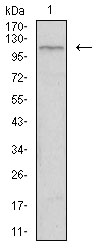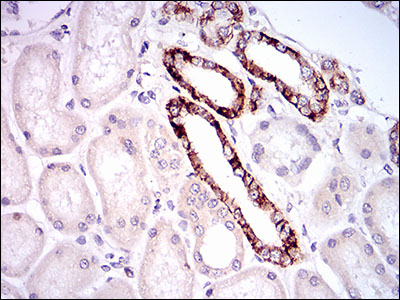Product Detail
Product NameTIE1 Antibody
Clone No.D2-D12
Host SpeciesMouse
ClonalityMonoclonal
PurificationProA affinity purified
ApplicationsWB, IHC
Species ReactivityHu
Immunogen DescRecombinant protein
ConjugateUnconjugated
Other NamesJKT 14 antibody
JTK14 antibody
TIE antibody
Tie1 antibody
TIE1_HUMAN antibody
Tyrosine kinase with immunoglobulin and epidermal growth factor homology domains 1 antibody
Tyrosine Kinase with Immunoglobulin and Epidermal Growth Factor Homology Domains antibody
Tyrosine kinase with immunoglobulin-like and EGF-like domains 1 antibody
Tyrosine protein kinase receptor Tie 1 antibody
Tyrosine-protein kinase receptor Tie-1 antibody
Accession NoSwiss-Prot#:P35590
Uniprot
P35590
Gene ID
7075;
Calculated MW125 kDa
Formulation1*TBS (pH7.4), 1%BSA, 40%Glycerol. Preservative: 0.05% Sodium Azide.
StorageStore at -20˚C
Application Details
WB: 1:500-1:2,000
IHC: 1:200-1:1,000
Western blot analysis of TIE1 on human TIE1 recombinant protein using anti-TIE1 antibody at 1/1,000 dilution.
Western blot analysis of TIE1 on HEK293 (1) and RAN-hIgGFc transfected HEK293 (2) cell lysate using anti-TIE1 antibody at 1/1,000 dilution.
Western blot analysis of TIE1 on HepG2 cell lysate using anti-TIE1 antibody at 1/1,000 dilution.
Immunohistochemical analysis of paraffin-embedded human ovarian cancer tissue using anti-CD68 antibody. Counter stained with hematoxylin.
Immunohistochemical analysis of paraffin-embedded human kidney tissue using anti-CD68 antibody. Counter stained with hematoxylin.
Receptor tyrosine kinases play key roles in signal transduction across cell surfaces in biological systems, including the vascular system. These receptors comprise a large and diverse family of catalytically related proteins that, on the basis of sequence and structural similarities, can be divided into several different evolutionary subfamilies. The cloning and characterization of Tie-1 (also designated Tie), a novel human endothelial cell surface receptor tyrosine kinase, has been reported. The extracellular domain of the predicted Tie-1 protein product has an unusual multidomain structure consisting of a cluster of three epidermal growth factor homology motifs localized between two immunoglobulin-like loops, which are followed by three fibronectin type III repeats next to the transmembrane region. An additional member of this family has been identified as Tie-2 (also designated Tek). Tie-1 and Tie-2 have been shown to be encoded by distinct genes and to represent members of a new class of receptor tyrosine kinases.
If you have published an article using product 48402, please notify us so that we can cite your literature.







 Yes
Yes



